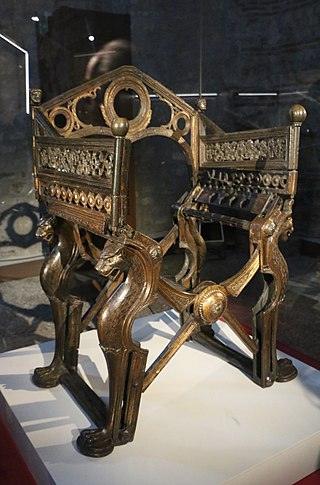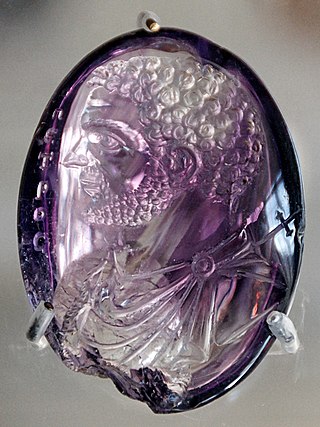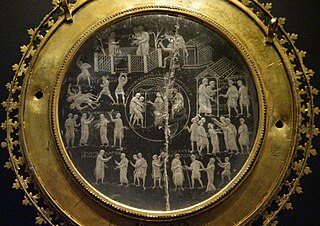
The Basilica of Saint-Denis is a large former medieval abbey church and present cathedral in the commune of Saint-Denis, a northern suburb of Paris. The building is of singular importance historically and architecturally as its choir, completed in 1144, is widely considered the first structure to employ all of the elements of Gothic architecture.

The Codex Aureus of St. Emmeram is a 9th-century illuminated Gospel Book. It takes its name from Saint Emmeram's Abbey, where it was for most of its history and is lavishly illuminated. The cover of the codex is decorated with gems and relief figures in gold, and can be precisely dated to 870, and is an important example of Carolingian art, as well as one of very few surviving treasure bindings of this date.

The French Crown Jewels and Regalia comprise the crowns, orb, sceptres, diadems and jewels that were symbols of Royal or Imperial power between 752 and 1870. These were worn by many Kings and Queens of France as well as Emperor Napoleon. The set was finally broken up, with most of it sold off in 1885 by the Third Republic. The surviving French Crown Jewels, principally a set of historic crowns, diadems and parures, are mainly on display in the Galerie d'Apollon of the Louvre, France's premier museum and former royal palace, together with the Regent Diamond, the Sancy Diamond and the 105-carat (21.0 g) Côte-de-Bretagne red spinel, carved into the form of a dragon. In addition, some gemstones and jewels are on display in the Treasury vault of the Mineralogy gallery in the National Museum of Natural History.

Carolingian art comes from the Frankish Empire in the period of roughly 120 years from about 780 to 900—during the reign of Charlemagne and his immediate heirs—popularly known as the Carolingian Renaissance. The art was produced by and for the court circle and a group of important monasteries under Imperial patronage; survivals from outside this charmed circle show a considerable drop in quality of workmanship and sophistication of design. The art was produced in several centres in what are now France, Germany, Austria, northern Italy and the Low Countries, and received considerable influence, via continental mission centres, from the Insular art of the British Isles, as well as a number of Byzantine artists who appear to have been resident in Carolingian centres.

Ottonian art is a style in pre-romanesque German art, covering also some works from the Low Countries, northern Italy and eastern France. It was named by the art historian Hubert Janitschek after the Ottonian dynasty which ruled Germany and Northern Italy between 919 and 1024 under the kings Henry I, Otto I, Otto II, Otto III and Henry II. With Ottonian architecture, it is a key component of the Ottonian Renaissance. However, the style neither began nor ended to neatly coincide with the rule of the dynasty. It emerged some decades into their rule and persisted past the Ottonian emperors into the reigns of the early Salian dynasty, which lacks an artistic "style label" of its own. In the traditional scheme of art history, Ottonian art follows Carolingian art and precedes Romanesque art, though the transitions at both ends of the period are gradual rather than sudden. Like the former and unlike the latter, it was very largely a style restricted to a few of the small cities of the period, and important monasteries, as well as the court circles of the emperor and his leading vassals.

Romanesque art is the art of Europe from approximately 1000 AD to the rise of the Gothic style in the 12th century, or later depending on region. The preceding period is known as the Pre-Romanesque period. The term was invented by 19th-century art historians, especially for Romanesque architecture, which retained many basic features of Roman architectural style – most notably round-headed arches, but also barrel vaults, apses, and acanthus-leaf decoration – but had also developed many very different characteristics. In Southern France, Spain, and Italy there was an architectural continuity with the Late Antique, but the Romanesque style was the first style to spread across the whole of Catholic Europe, from Sicily to Scandinavia. Romanesque art was also greatly influenced by Byzantine art, especially in painting, and by the anti-classical energy of the decoration of the Insular art of the British Isles. From these elements was forged a highly innovative and coherent style.

The Cup of the Ptolemies, also known as the Cup of Saint Denis, is an onyx cameo two-handled cup, or kantharos. The cup, decorated with Dionysiac vignettes and emblems, was carved at some point in Classical Antiquity, probably in Alexandria. Eventually, it found its way into the treasury of the French kingdom, before it was donated to the abbey of St. Denis. During the Middle Ages, it was used as a Christian chalice, and lavish mounts were added, with Latin inscriptions. In 1804, the cup was stolen, and the mounts were lost, although the cup itself was recovered. It is now in the Cabinet des Médailles at the Bibliothèque nationale de France, Paris.

The Imperial Sword is one of the four most important parts of the Imperial Regalia (Reichskleinodien) of the Holy Roman Empire. During a coronation, it was given to the emperor along with the Imperial Crown (Reichskrone), Imperial Sceptre (Reichszepter), and the Imperial Orb (Reichsapfel). All four parts of the Imperial Regalia are displayed in the Imperial Treasury at the Hofburg Palace in Vienna, Austria. It is also known as Mauritiusschwert, or the sword of Saint Maurice.

Giovanni Bernardi, also known as Giovanni da Castel Bolognese and as Giovanni da Castelbolognese, was an Italian gem engraver and medallist who was born in Castel Bolognese, Italy. He was the son of a goldsmith and by 1530 had moved to Rome, where he had a position in the Papal mint, which also allowed him time to work for other patrons. These included Cardinal Ippolito de' Medici (1511–35), Pope Clement VII (1523–34), Cardinal Alessandro Farnese, the future Pope Paul III, as well as his grandson, also called Cardinal Alessandro Farnese. He was "a skillful composer of elegant nudes in elaborate scenes".

The Psalter of Oswald also called the Ramsey Psalter is an Anglo-Saxon illuminated psalter of the last quarter of the tenth century. Its script and decoration suggest that it was made at Winchester, but certain liturgical features have suggested that it was intended for use at the Benedictine monastery of Ramsey Abbey in Huntingdonshire, or for the personal use of Ramsey's founder St Oswald.

The Throne of Dagobert or Chair of Dagobert is a bronze chair made in the early Middle Ages and long associated with the Frankish and later French monarchy. After having been kept for centuries at the Abbey of Saint-Denis, it is now at the Cabinet des médailles of the Bibliothèque nationale de France in Paris.

An engraved gem, frequently referred to as an intaglio, is a small and usually semi-precious gemstone that has been carved, in the Western tradition normally with images or inscriptions only on one face. The engraving of gemstones was a major luxury art form in the Ancient world, and an important one in some later periods.

Hardstone carving, in art history and archaeology, is the artistic carving of semi-precious stones, such as jade, rock crystal, agate, onyx, jasper, serpentinite, or carnelian, and for objects made in this way. Normally the objects are small, and the category overlaps with both jewellery and sculpture. Hardstone carving is sometimes referred to by the Italian term pietre dure; however, pietra dura is the common term used for stone inlay work, which causes some confusion.

The Cross of Lothair or Lothair Cross is a crux gemmata processional cross dating from about 1000 AD, though its base dates from the 14th century. It was made in Germany, probably at Cologne. It is an outstanding example of medieval goldsmith's work, and "an important monument of imperial ideology", forming part of the Aachen Cathedral Treasury, which includes several other masterpieces of sacral Ottonian art. The measurements of the original portion are 50 cm height, 38.5 cm width, 2.3 cm depth.

The Lothair Crystal is an engraved gem from Lotharingia in northwest Europe, showing scenes of the biblical story of Susanna, dating from 855–869. The Lothair Crystal is an object in the collection of the British Museum.

The Holy Thorn Reliquary was probably created in the 1390s in Paris for John, Duke of Berry, to house a relic of the Crown of Thorns. The reliquary was bequeathed to the British Museum in 1898 by Ferdinand de Rothschild as part of the Waddesdon Bequest. It is one of a small number of major goldsmiths' works or joyaux that survive from the extravagant world of the courts of the Valois royal family around 1400. It is made of gold, lavishly decorated with jewels and pearls, and uses the technique of enamelling en ronde bosse, or "in the round", which had been recently developed when the reliquary was made, to create a total of 28 three-dimensional figures, mostly in white enamel.

The Lindau Gospels is an illuminated manuscript in the Morgan Library in New York, which is important for its illuminated text, but still more so for its treasure binding, or metalwork covers, which are of different periods. The oldest element of the book is what is now the back cover, which was probably produced in the later 8th century in modern Austria, but in the context of missionary settlements from Britain or Ireland, as the style is that of the Insular art of the British Isles. The upper cover is late Carolingian work of about 880, and the text of the gospel book itself was written and decorated at the Abbey of Saint Gall around the same time, or slightly later.

The Cross of Mathilde is an Ottonian processional cross in the crux gemmata style which has been in Essen in Germany since it was made in the 11th century. It is named after Abbess Mathilde who is depicted as the donor on a cloisonné enamel plaque on the cross's stem. It was made between about 1000, when Mathilde was abbess, and 1058, when Abbess Theophanu died; both were princesses of the Ottonian dynasty. It may have been completed in stages, and the corpus, the body of the crucified Christ, may be a still later replacement. The cross, which is also called the "second cross of Mathilde", forms part of a group along with the Cross of Otto and Mathilde or "first cross of Mathilde" from late in the preceding century, a third cross, sometimes called the Senkschmelz Cross, and the Cross of Theophanu from her period as abbess. All were made for Essen Abbey, now Essen Cathedral, and are kept in Essen Cathedral Treasury, where this cross is inventory number 4.

The Orsini Altarpiece, Orsini Polyptych or Passion Polyptych is a painting produced at an unknown location by Simone Martini for private devotion by a cardinal of the Orsini family. Its precise date is still under discussion. It was taken to France very early in its lifespan and formed a major influence on late medieval French artists. It is now split between the Louvre, the Royal Museum of Fine Arts, Antwerp and the Gemäldegalerie.
The Treasury of Saint-Denis, kept at the Basilica of Saint-Denis in Paris until the French Revolution, was the main repository of the regalia of the Kingdom of France, including the ancien régime portion of what are now known as the French Crown Jewels. Its surviving items are presently scattered between the Louvre, the Cabinet des Médailles of the French National Library, and other museums.



















